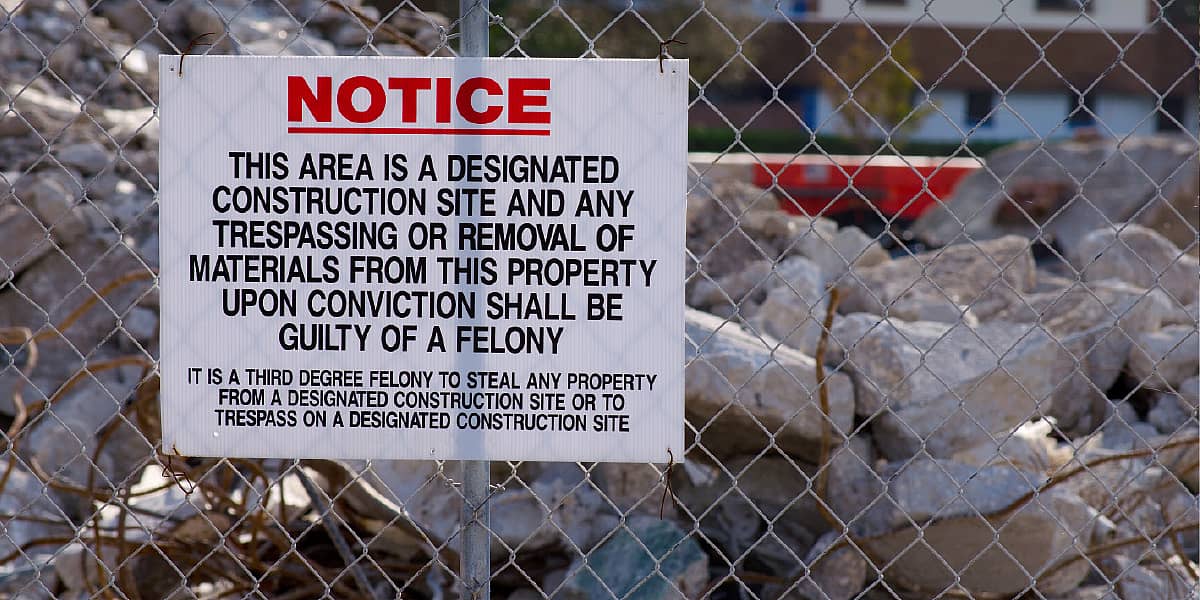The National Insurance Crime Bureau and the National Equipment Register estimate the cost of U.S. construction-site crime to be between $300 million and $1 billion annually, with just 10 states accounting for over 63% of that.
What’s a wall and ceiling contractor to do?
Some have more questions than answers. One such contractor is Cameron Wies, president and COO at Missouri’s T.J. Wies Contracting, Inc. He admits that his company has not come up with a workable solution: “Honestly, I am more interested in learning from this article than trying to provide any good input on how to prevent theft, because all the solutions we have are not really working. We have tried RFID tags and others, but the GPS locations for these are very broad and not usable for actual recovery.”
However, he also considers the human side of the problem: “The best option we have found so far is, first and foremost, to hire the right people and do everything possible to keep the honest man honest.”
How bad is it?
Perhaps the disproportional distribution of this crime among states accounts for the significantly differing reports from AWCI members around the country, as you will see.
In gathering feedback from AWCI contractors we first asked about the magnitude of the jobsite theft situation in their neck of the woods.
“We only average around three thefts a year,” says Clint Edwards, operations manager of framing and finishes for Heartland in Iowa. “These are all from new-build job sites, most of which are dimly lit and away from other buildings. We do lose some hand tools when we slow down or lay off some workers, when they may steal something from us.”
Randy Washington, owner, president and CEO of LSN Contractors and Construction Managers in Pennsylvania, says, “There have been instances where tools or accessories have gone missing. It used to happen too frequently, so we implemented protocols for tools that have helped tremendously.” (These protocols are detailed later in this article. Keep reading.)
“We see mostly low-level petty theft, usually from another trade worker stealing screw guns, lasers and small tools,” says Nate Hillestad, senior vice president at Western Partitions Inc. in Nevada. “There may be one occasional larger theft by homeless people or criminals. We probably average one insurance claim per year relating to theft.”
Zoya Sather, operations manager at LS Drywall, Inc. in Minnesota, says, “Luckily, there hasn’t been much theft other than a year ago. There was an instance when all our tools were stolen—lasers, framing guns, etc.—at a job in North Dakota. We reported it to the police. The foreman had been provided with a locked trailer, but this one time he did not store the tools properly. Another trade from the same project had their entire trailer stolen. This happened within the same week, in the dead of winter.”
Favorable feedback comes from Veronica DeBonise, president of G&G Plaster, EIFS & Drywall, Inc. in Massachusetts: “We have been fortunate and have not experienced a lot of theft.”
Jerry Reicks Jr., president of Tri-State Drywall in Iowa, says, “Here in Iowa it is not rampant. It is what I would call normal. On most job sites the men keep fairly good track of their tools, and bigger ones are locked in a gangbox. We did lose a trailer three years ago, which has not been found. We have also had some problems in our supply company with materials stored outside our fence,” he concludes.
“Theft on job sites has always been a concern in the construction industry, but our company has largely managed to avoid it over the years,” says James Kahler, president and CEO of Northwest Partitions in Washington. “However, this year, theft is on the rise, and some of our projects have been targeted. Thieves have managed to make off with tens of thousands of dollars’ worth of our tools and equipment. What’s particularly concerning is that these thieves are becoming increasingly bold, stealing anything and everything, from brooms to paint pumps. In previous years, thieves tended to target projects that were not yet fully enclosed and were therefore easy to enter. But this year, they are even targeting nearly completed projects and renovation projects that are fully enclosed, locked and even under surveillance.”
Larry Cowper, director of self-perform operations at Clark Contracting Services in Michigan, describes a more significant level of theft in his area: “We have encountered some theft on project sites that occurred due to lack of site security. Entire gangboxes have been stolen with all contents. The thieves cut the chains securing our boxes to structural columns and removed them from the site.”
The situation in Texas, or at least in the Houston area, is more severe. “There is a significant amount of jobsite theft even on secured equipment and sites,” reports Bill Fritz, CEO of Mission Interior Contracting. “We feel most of it is internal from workers on site who are somehow involved with organized crime. Many of the sites have cameras that are disabled when the theft occurs. It seems every year the theft increases, no matter what you do to prevent it.”
Rick Wagner, owner of Richard Wagner Enterprises, LLC in North Carolina says his company has experienced minimal theft, but he says, “On the larger jobs with so many other trades and temp workers involved, we have the highest losses.”
Adam Barbee, project executive at Daley’s Drywall & Taping in California, explains the situation there, which is quite serious. “It’s generally an organized outfit,” he says. “They survey the job over time to observe the schedule, development and sequencing of the job site. Unfortunately, sometimes they have someone on the inside to help orchestrate it. While sometimes these thefts are carried out by individuals, in most cases, based on the magnitude of theft at some of the jobs, it’s a good size group, well-prepared, getting in and out with a sizable number of stolen items.”
What measures are being taken to counter jobsite theft?
Our next question was aimed at finding out what measures were being taken to prevent the theft and to recover stolen items if theft did occur. While the measures are different from contractor to contractor, there are several common practices.
“We chain and padlock all equipment to a column on the job site,” says Edwards. “If it’s an open site, we have a job trailer that is locked up. All our tools are tagged with an ID number and our name. If the police find our stolen tools, we can then pick them up from the police station.”
Washington shares his company’s approach: “We have established a tool log that is reviewed with our shop manager and project foremen on a regular basis. Each tool is assigned a number and given an asset tag with that number. Then each tool is logged in or out, and the shop manager touches base with project foremen regularly to make sure they still need certain tools on site. If they are not needed, they are returned to the shop and logged back in.”
“Most of our larger project sites have job security provided by the GC,” says Hillestad. “As for our internal security, we rely on lockup cages, gangboxes, CONEX boxes and daily check-in and -out of larger tools and equipment. We also use RFIDs and tracking chips as needed.”
Cowper says, “CCS has implemented a tool tracking software that utilizes Bluetooth and GPS technology to help mitigate theft and loss. We have also implemented additional branding of our tools and equipment to better identify them from those of other contractors, which helps if they end up in someone else’s gangbox or truck.”
“We take precautions to protect our tools, such as storing them in locked job boxes and chaining items to the building structure,” says Kahler. “We’re investing in some new types of chains that are supposedly harder for thieves to cut. We also attempt to keep our tools and equipment out of the sight of potential thieves.”
Sather says, “Everyone is provided with locked gangboxes or locked enclosed trailers, depending on how big the project is. All our tools also have tracking systems now.”
“We place all tools in locked gangboxes,” says DeBonise. “We mark our equipment with our name. Ladders are spray painted. We also use permanent markers. We talk to the GC superintendent if items are missing. Usually someone has borrowed something, and we make sure it is returned.”
Reicks says, “In the last three months, we put in a new camera security system that is bigger and better than the last one.”
“We try to coordinate shipping materials to the site the same morning so we can begin installation, although coordination is not always possible,” explains Fritz. “Tools are the responsibility of our workers, while equipment such as scaffolding, ladders and scissor lifts are secured with cable and lock. We always pay the rental protection fee to the lift supplier simply as part of doing business,” he adds.
Wagner explains the procedures at his company in North Carolina: “We etch and label every piece from brooms to lasers and scaffolds.”
Barbee says, “We lock up all equipment and tools on the job sites. That’s the best we can do as a first step. If it escalates to repeat occurrences, we work with the GC to hire on-site security. It’s very hard to recover stolen tools. We document all lost items and file a police report. Occasionally we may recover some lost tools, but usually it’s a 100% write-off.”
What have proved to be the most effective measures?
Sather recommends a tagging and tracking system, and Hillestad says “jobsite security staff, fences and cameras are the largest deterrent, coupled with lock-up boxes in all forms.”
“Locking tools in gangboxes and chaining them up,” is how Edwards and his company prevent theft. “When we do this, it makes it harder for them and they will just grab the items laying around. Most jobs don’t have Wi-Fi, so using cameras is not possible. GPS tagging of tools is very expensive.”
Washington stresses the human element. “Communication and accountability have been a big help,” he says. “If the project foreman knows he is responsible for the tools once they hit the job site, there tends to be more accountability, and time is taken at the end of the day to make sure all tools are safely locked away.”
“Tool tracking and inventory,” says Cowper. “Many of the small losses are not noticed until project demobilization. We have been able to shrink tool loss and theft with biweekly or monthly jobsite auditing.”
Kahler says, “These criminals are spending significant amounts of time on projects, ransacking and stealing from all the trades on-site. They often use torches and grinders to cut through job boxes, locks and chains. While we can’t identify the culprits, it wouldn’t be surprising if they were linked to some organized crime ring.”
DeBonise says, “Putting tools away in their designated storage area and making sure areas are secure from the public are the most workable solutions. I think the fact that G&G Plaster is a 100% commercial subcontractor plays a big role in not experiencing a lot of theft. GCs and owners of projects arrange to have equipment and tool areas, fencing in of projects and an awareness of who is on the job.”
Wagner says, “The best security is a good foreman!” Then he adds, “When we do catch a thief, we typically take them to the top floor of the project and test their safety harness!” Even though said in jest, the thought has probably crossed the minds of many contractors who are trying to get their job done and really don’t need or have time for the antics of the criminal element.
Barbee says that “job site security, or a secure building are the best measures of prevention. Anything and everything of value must at the least be locked up or stored in a locked container.”
“Full-time guard on site? Who wants that cost?” asks Fritz, “There really is no effective measure. If there were, theft losses would not continue to climb year after year,” he concludes. Nevertheless, Mission Interior Contracting does take all the usual precautions to mitigate the problem.
Many solutions have been offered to a situation that is distributed unevenly around the country, with varying degrees of success. Perhaps the most sensible approach is to take all reasonable precautions to prevent jobsite theft as mentioned by AWCI members above, including human precautions, methodical administration and the use of the best available technology—but without allowing the expense to become so high that it overshadows the potential loss from theft, and without putting so much attention on the subject that it distracts from the work that needs to be done.
David C Phillips, a freelance writer and photographer, is an original founding partner at Words & Images.





